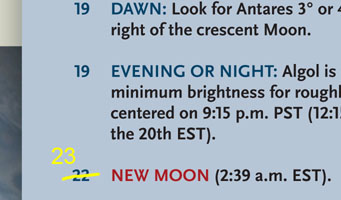 The editors of Sky & Telescope make every effort to provide accurate information, but errors do sometimes slip through. We correct all mistakes online as well as printing corrections in the magazine. So if you see something questionable in the magazine, check below to see if it's a known problem.
The editors of Sky & Telescope make every effort to provide accurate information, but errors do sometimes slip through. We correct all mistakes online as well as printing corrections in the magazine. So if you see something questionable in the magazine, check below to see if it's a known problem.
This article lists all known errors in issues of Sky & Telescope for 2013. See also the errata listings for other years.
January 2013
Page 76: The gallery photograph of NGC 2070 was a collaboration by a team of imagers including Lorenzo Comolli, Giosuè Ghioldi, Luigi Fontana, and Emmanuele Sordini, not just Comolli as stated. The same is true for the gallery image of the Pipe Nebula in the February issue, page 79.
February 2013
Page 12: Sunlight at Uranus is about 1⁄400 as strong as it is on Earth, not 1⁄900 as stated.
Page 63: Photos credited to the author of the Telescope Workshop column should be credited to the author’s subject, Albert Highe.
June 2013
Page 9: Sir Patrick Moore lived in Selsey, not Chelsea.
July 2013
Page 16: It would take about 10 protons to make the dark matter particle (mass 10 GeV) implied by the CDMS experiment, not 10 protons to make 1 GeV.
Page 38: Despite Struve’s preeminence, William Herschel in fact discovered that Eta Coronae Borealis is a double star in 1782, long before Struve’s work in 1826.
Page 40: A clarification: by describing the area just north of Zeta Scorpii as being "just north of the eastern bend of the fish hook," we meant where the hook bends eastward, not the eastern edge of the hook (this area is on the western edge of the hook).
August 2013
Page 57: The star labeled Eta below the arc of three dark nebulae should be labeled 12. Eta is the nearby star in Scutum.
Page 58: The planetary nebula shown is NGC 6751, not 6571 (5 and 7 are transposed). The nebula is correctly identified on the previous page.
Page 79: The photo of Comet PanSTARRS was taken by Steve Riegel, not Rigel as stated. (Apparently we had Orion on the brain.)
September 2013
Page 26: The spectrum labeled "Comparison star" should instead be labeled "Comparison spectrum." The comparison spectrum is an emission spectrum from an arc lamp, a low-density gas-filled tube through which a current is run to excite atoms. Usually these atoms are some combination of neon, argon, helium, and iron.
Page 30: The ConVento group of stellar spectroscopists was formed by a group of amateurs and professionals at a workshop in Portugal that included Thomas Eversberg and Anthony Moffat. The group took its name from the monastery where the meeting was held (Convento da Arrábida), not from the Italian for “with wind” as stated in the article. You can read more on the workshop's website.
Page 58: in the description of GN 20.43.9, the "very faint drop of nebulosity" dangles from the star at the eastern corner of the 5-arcminute-tall kite, not the one at the western corner as stated.
November 2013
Page 70: The caption beneath the antenna photo improperly implied that the particular antenna shown perfectly matched the description of antennas useful to these CubeSat monitoring projects: this antenna is a bit pricier than the low-cost ham-radio setups we had in mind.
 0
0

Comments
You must be logged in to post a comment.